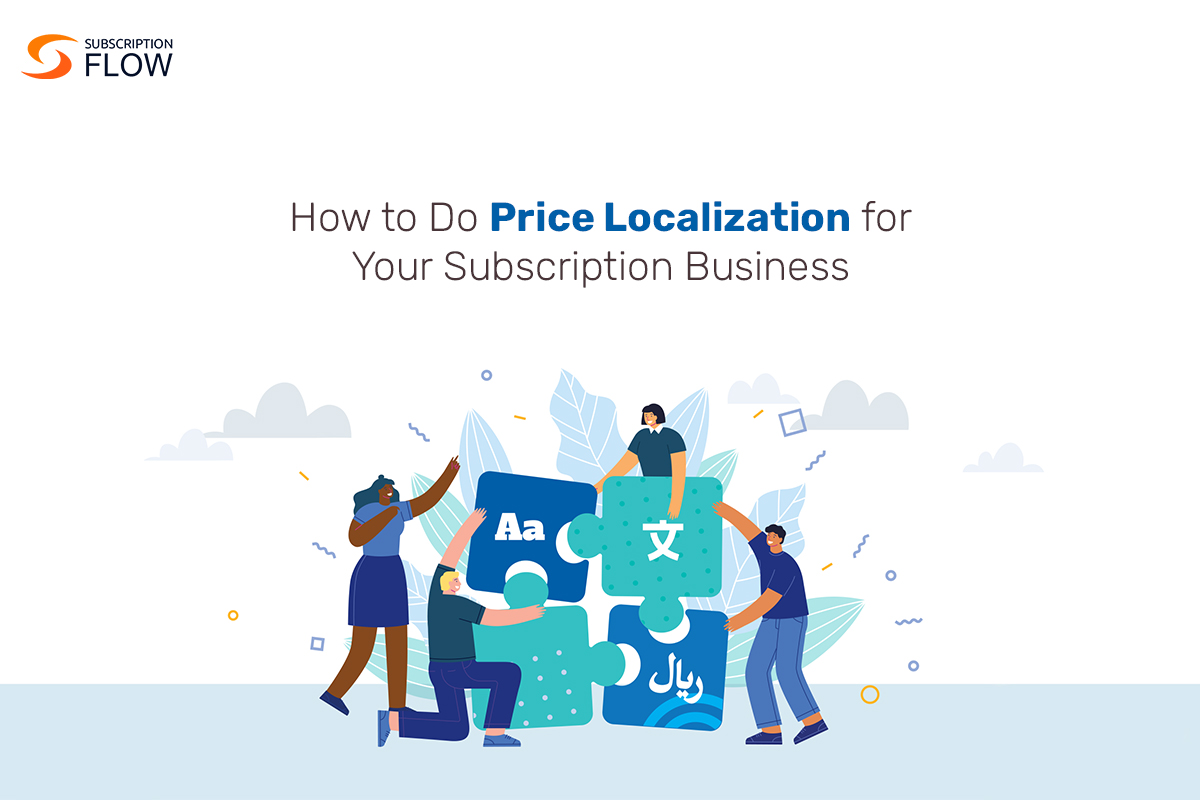
40 Rules of Doing Price Localization for Your Subscribers
The world is interconnected, and today, businesses have unprecedented opportunities to tap into global markets. This great expansion may come with challenges, especially when it comes to pricing plans. But price localization can help you compete better and satisfy your customers locally and internationally.
Every retailer in the subscription business market dreams of catering to national and international customers. Even, in many cases, customers are aware of a certain brand and company offering subscriptions for certain services. However, when you do not let them pay you in their local currency, the chances of bringing them on board automatically lessen.
In this article, we’ll tell you 40 rules for mastering the art of price localization. From understanding local buying habits to navigating complex currency exchange rates, we’ll provide you with a roadmap to ensure that your pricing strategies align seamlessly with the unique needs and expectations of your subscribers worldwide.
1. Do Market Research to Understand Local Buying Habits
Market research is the compass of price localization, guiding you to comprehend the distinct buying behaviours, preferences, and cultural influences that shape the purchasing decisions of your target audience in each unique locale.
2. Adjust Prices Based on Currency Exchange Rates
The second rule of doing price localization is to adjust prices based on the currency exchange rates. Now, currency rates change frequently. You need to have a robust payment processor (payment gateway integration) for your subscription business price localization. Payment gateways do this seamlessly so that you do not need to do anything and payments are transferred as per the currency rates of the chosen currencies.
3. Offer Region-Specific Discounts or Promotions
Coming towards discounts and promotions that are part of every company’s pricing plans and policies. If you are also offering discounts for your subscribers, then they have to be region-specific. This targeted approach demonstrates your commitment to local customers, fostering brand loyalty and engagement.
4. Consider Local Income Levels When Pricing Products
Consideration of local income levels is essential to ensure your pricing aligns with the financial capacities of your target market, allowing you to strike the right balance between affordability and profitability while catering to diverse economic landscapes. This approach not only widens your customer base but also fosters inclusivity and customer satisfaction.
Also Read: Choosing Subscription Pricing Models to Maximize Conversion and Boost Sales
5. Set Competitive Prices Compared to Local Competitors
In the local market, you need to offer a price that is competitive enough to help you earn fair recurring revenue. Competitive pricing also helps you cater to more customers. In a highly competitive market, you can offer the pricing that your competitors are also offering but include some perks. For instance, you can offer a freemium plan.
6. Adapt Pricing to Accommodate Local Taxation Policies
Pricing must be adjusted to take into account local tax laws and rates in order to ensure compliance and transparency while avoiding unpleasant surprises for clients at the point of sale. You demonstrate a dedication to fair pricing and uphold a positive reputation in each market by handling these complexities.
7. Create Tiered Pricing for Different Customer Segments
Today, subscriptions are so popular among people because this business model tries to cater to customers from all segments of society. You also need to make different pricing tiers to onboard customers from all segments so that it will help you in price localization.
8. Use Psychological Pricing Tactics for Local Markets
In the local subscription business market, you must know the psychological factors that can help you win customers and earn targeted revenue. Also, when it comes to pricing in a new market, it is crucial to understand the mindset of locals regarding pricing for what you offer.
9. Implement Dynamic Pricing Strategies
Implementing dynamic pricing strategies involves using real-time data and algorithms to adjust product prices based on factors such as demand, competitor pricing, and inventory levels that you need for price localization.
Also Read: How Tiered Pricing Strategy Can Help You Retain B2B Customers
10. Factor in Shipping and Import/Export Costs
For instance, if you offer subscriptions in the eCommerce market, then you need to have inventory management and import/export regulations as per the market where you are operating.
11. Offer Bundle Deals Tailored to Local Preferences
As it has been mentioned, for price localization, you need to offer discounts accordingly. Likewise, you can plan bundled deals for local customers so as to increase the customer base.
12. Adjust Prices for Seasonal Variations in Demand
In different regions, season cycles differ and vary. Your pricing plans and strategies ought to be in accordance with the season of the region where you are taking your subscription business.
13. Consider Cultural Nuances When Setting Price Points
This rule tells subscription business retailers to keep cultural nuances in account while deciding the pricing of their products or services. This sensitivity to cultural factors helps build trust and reliability with customers in diverse markets
14. Optimize Pricing for Mobile and eCommerce Platforms
To provide a seamless and user-friendly purchasing experience, it’s important to make sure that your product prices are shown simply and effectively on mobile and eCommerce platforms. This strategy makes use of the rising popularity of mobile and online shopping to boost sales and customer satisfaction.
15. Customize Pricing Based on Customer Loyalty Programs
In different regions, the loyalty of customers can vary. You need to offer customers loyalty programs to keep them on board depending on their loyalty to your product or services.
16. Provide Local Language Pricing and Product Information
One of the very important rules for price localization is to communicate with your targeted customers in their local language. For instance, an American SaaS retailer cannot expect to grow and scale in Asia or Africa if it does not communicate in the local language. Different payment gateways offer multi language support so that they can support your plan of SaaS price localization.
17. Offer Currency Conversion Tools on Your Website
When you are implementing your pricing plans and strategies, currency conversion is of immense importance. So, many payment gateways do this for you automatically. We suggest you integrate a top payment gateway with your automated subscription billing system to run everything smoothly.
18. Collaborate with Local Partners for Pricing Insights
Collaborating with local partners for pricing insights enables you to tap into their market knowledge, customer preferences, and competitive landscapes. This collaboration provides invaluable information for crafting pricing strategies that resonate with the local audience, enhancing your market presence and competitiveness.
19. Implement Region-Specific Price Floors and Ceilings
Setting minimum and maximum pricing limitations based on the economic conditions and consumer expectations of each market is necessary to implement region-specific price floors and ceilings. This is very important for price localization.
20. Test and Analyze Pricing Strategies for Each Market
You also need to analyze and delve into the details of pricing strategies that people are already using in your targeted subscription business market so that you can localize your pricing plans accordingly.
21. Utilize A/B Testing for Pricing Experiments
Collaborating with local partners for pricing insights enables you to tap into their market knowledge, customer preferences, and competitive landscapes. This collaboration provides invaluable information for crafting pricing strategies that resonate with the local audience, enhancing your market presence and competitiveness.
22. Consider Local Payment Preferences and methods
In a specific market, you need to keep local payment preferences in consideration. For instance, in specific regions, some specific payment gateways are working while others do not work over there. Paystack is widely used across Africa, it is not a preference in America or Europe.
23. Offer Localized Payment Plans or Financing Options
This approach enhances affordability and purchasing flexibility, making your products more accessible and appealing to a broader audience in each market.
24. Monitor Competitor Pricing and Adjust Accordingly
In the subscription business market, most of the time, you cannot continue working with the same pricing plans for a long time. You need to improvise pricing from time to time. This rule suggests you monitor the pricing plans of competitors as well and adjust accordingly.
25. Implement Price Elasticity Models for Each Market
Implementing price elasticity models for each market involves understanding how sensitive consumer demand is to changes in price. Implementation of this rule will help you set the lowest and highest price brackets for your subscribers.
26. Use Geolocation-Based Pricing on eCommerce Sites
Using geolocation-based pricing on eCommerce sites involves automatically adjusting product prices based on the user’s location, offering personalized and region-specific pricing. Implement this rule for ease of operations in specific regions.
27. Adjust Prices Based on Historical Sales Data
The feature of analytics is very important for subscription businesses. With the help of this feature, you need to observe the historical data and make your sales and pricing policies. Make adjustments in the pricing in a way that you will be able to maximize sales.
28. Create Customized Pricing for Subscription Models
One of the rules that will help you a lot in the subscription business market is to offer your targeted subscribers to have customised pricing plans depending on their needs and budget. It will help you onboard customers from all segments of society.
29. Offer Volume Discounts for Bulk Purchases
Offering volume discounts for bulk purchases encourages customers to buy in larger quantities, thereby increasing the average order value and fostering loyalty among bulk buyers.
30. Adjust Prices During Local Holidays or Events
On Black Friday and Cyber Monday, different brands make record sales. Subscription businesses can also get benefits on these days of hyper-economic activity. Offer customers special prices on holidays etc.
31. Utilize Dynamic Pricing for Perishable Goods
Utilizing dynamic pricing for perishable goods involves adjusting prices in real time based on factors like supply, demand, and expiration dates. This strategy minimizes waste and maximizes revenue by ensuring that prices align with market conditions, optimizing profitability for products with limited shelf life.
32. Provide Loyalty Rewards Specific to Each Market
You need to motivate customers, in the subscription business market, to continue purchasing from your company. For that, one of the best strategies is to offer loyalty rewards as per the trends of specific markets.
33. Consider the Impact of Shipping Lead Times on Pricing
Shipping lead time affects shipping prices. Offer different shipping options with clear pricing to meet customer needs and expectations.
34. Monitor and Respond to Customer Feedback
In a new market, it is crucial to see what your customers say. So, whatever they give feedback regarding pricing, do not neglect it rather work on it. Monitor the feedback to offer customer-optimized pricing.
35. Implement Pricing Tiers Based on Product Features
When you are crafting pricing tiers, always keep your features in consideration. Today, customers are informed and enlightened. They never want to pay you more than for what they have used. Keep your customers satisfied by offering features in a competitive price range.
36. Adjust Prices for Import/Export Regulations
Adjust prices for import/export regulations to comply with local laws and avoid unexpected expenses.
37. Use Regional Market Baskets for Pricing Insights
Using regional market baskets for pricing insights involves analyzing typical product assortments and shopping habits in specific geographic areas. This approach helps you tailor your pricing strategies to match the preferences and purchasing patterns of local customers, ensuring that your offerings are both appealing and competitive in each market.
38. Offer Local Payment Gateways and Options
When you need to enter a new subscriber market, it is suggested to offer your customers payment options with a payment gateway that is locally renowned, popular, and trusted. Customers will not prefer to pay in Asia with the payment gateways that you easily use in Europe or elsewhere. You will probably need to integrate other payment gateways to enter this entire region.
39. Continuously Refine Pricing Strategies Based on Market Trends
Subscription business market trends change, just like any other market. When you are deciding on pricing tiers, it is important to make pricing strategies and improvise them with time as per the ongoing trends.
40. Monitor and Respond to Regulatory Changes
Stay vigilant and proactive by monitoring changes in local regulations and laws that can impact pricing. However, automated billing and payment processors are opted so that retailers may not need to do this manually. Also, manually having an eye on local regulations is not possible.
Hopefully, these forty rules of price localization will help you set the right price for your subscription business to enter a new market. However, SubscriptionFlow is the platform that can help you easily enter a new market and hunt new customers with ease. We support your pricing plans and strategies like no one else can. Also, our subscription management system integrates with leading payment gateways in every region may it be Europe or Africa.










